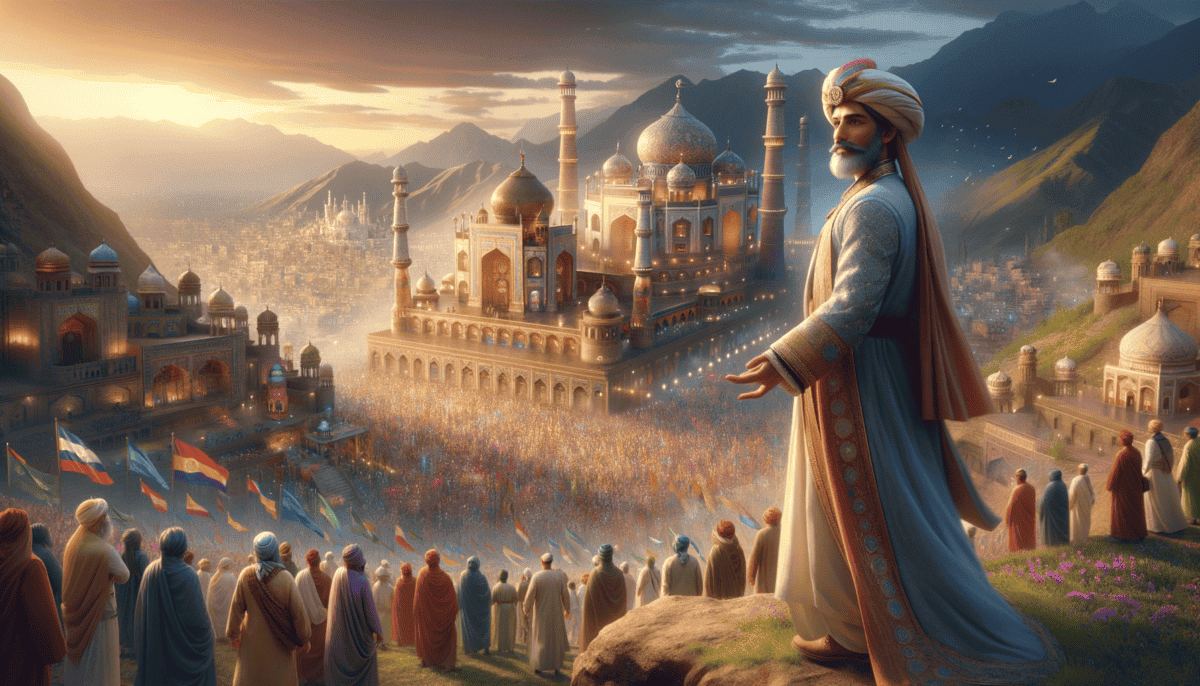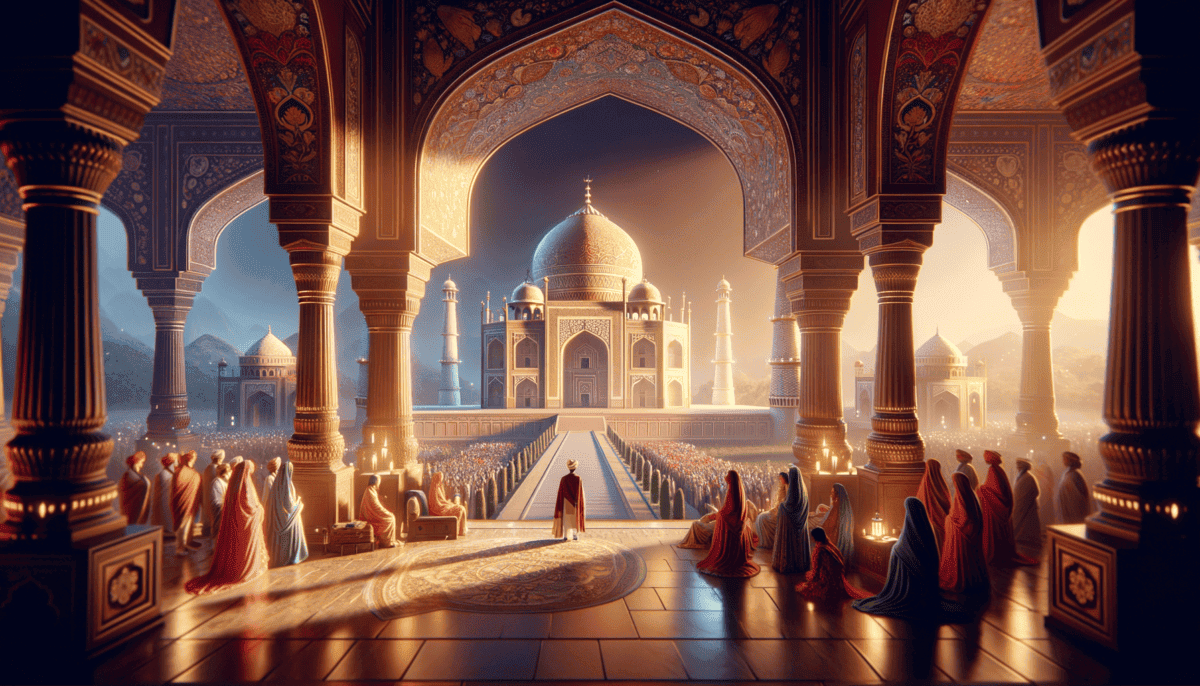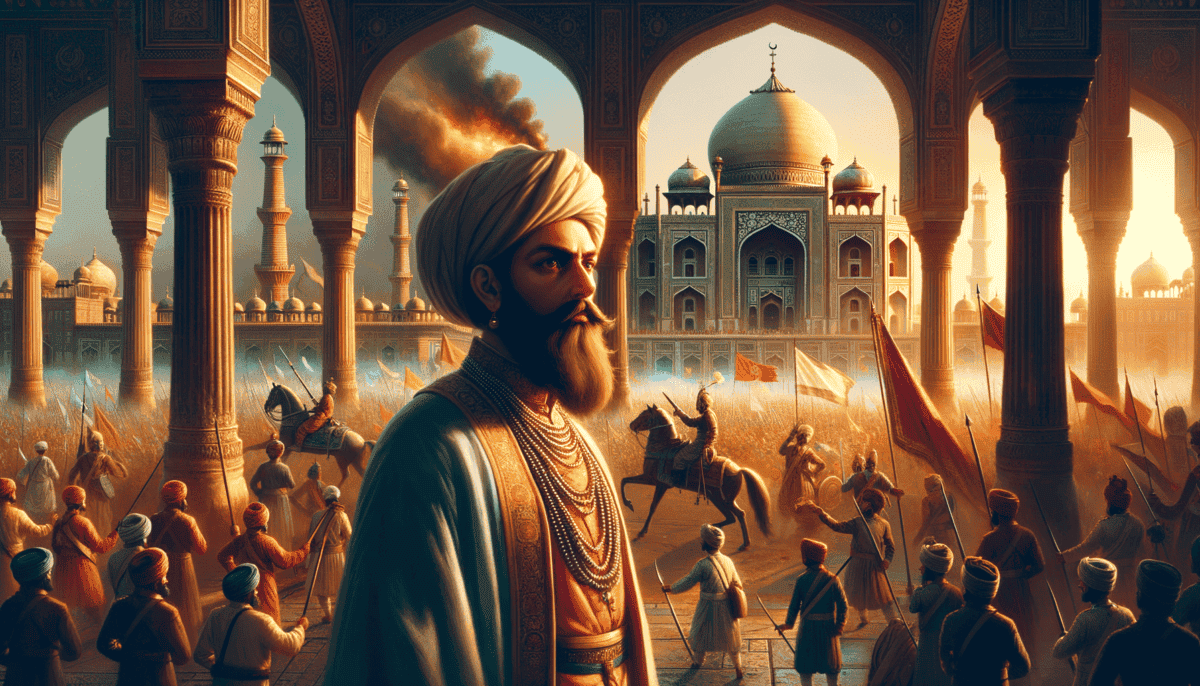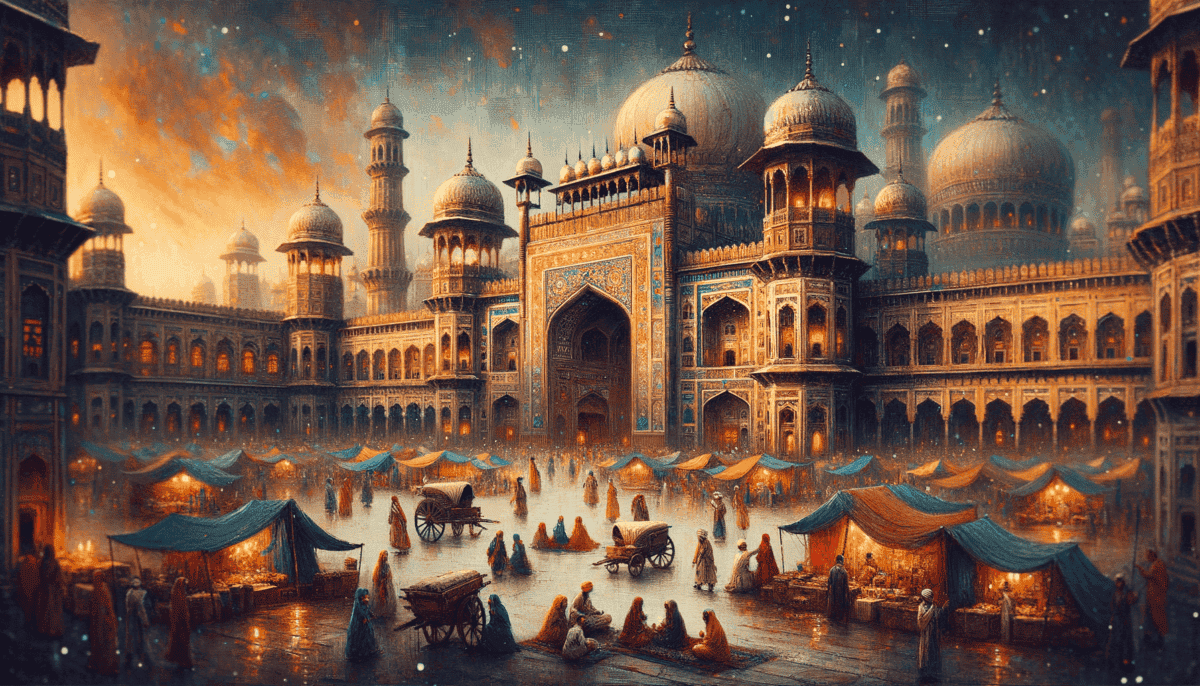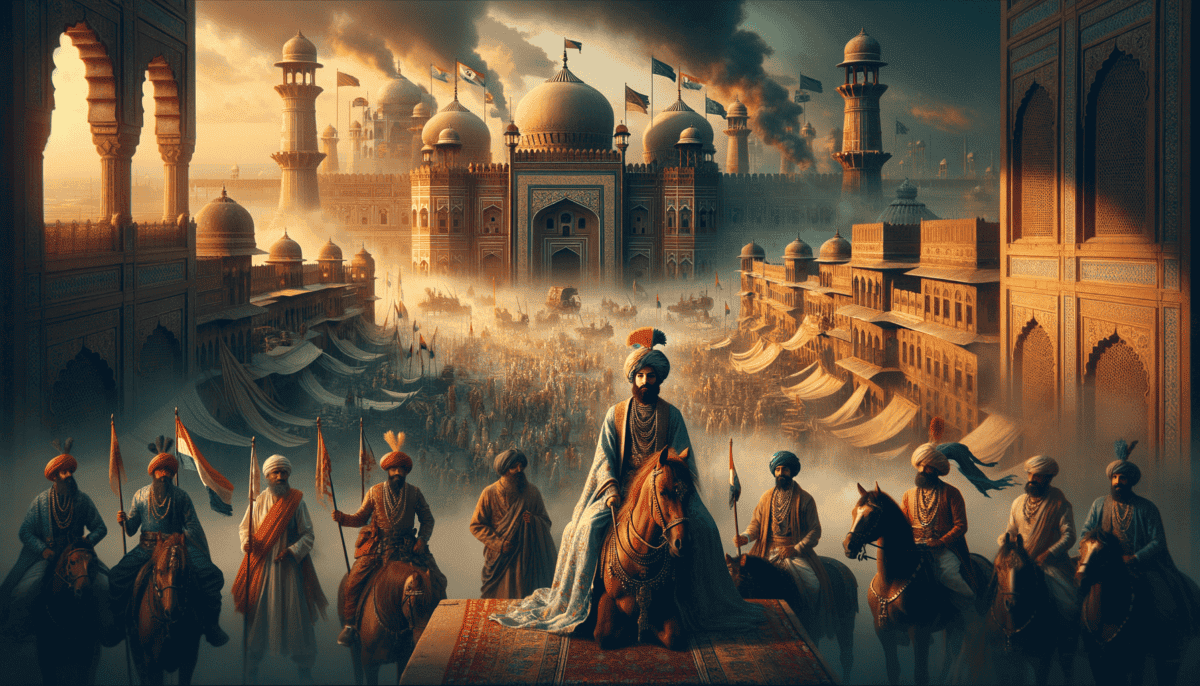The Conqueror’s Journey
In a land far away, where mountains touched the sky and rivers flowed like silver ribbons, lived a young prince named Babur. He was just twelve years old when he became the ruler of a small kingdom called Ferghana.
Babur loved to ride horses and explore the mountains around his home. But being a young ruler wasn’t easy. Sometimes other kings tried to take his land. This made Babur sad, but it also made him brave and strong.
Dreams of a New Land
One day, Babur heard stories about a rich land called Hindustan (now called India). The stories told of beautiful cities, green forests, and lots of treasures. His eyes would light up whenever traders brought news from this magical place.
“I want to see this wonderful land,” Babur would tell his friends. “And maybe one day, I can make it my home!”
“My heart kept pulling me toward Hindustan, like a magnet pulls iron,” Babur wrote in his diary.
The Big Battle
In 1526, when Babur was grown up, he decided to follow his dream. He gathered his brave soldiers and marched toward Hindustan. His army wasn’t very big, but they had something special – big guns called cannons!
On a hot April day, Babur’s army met the army of Ibrahim Lodi, who ruled Delhi. They fought at a place called Panipat. Babur was clever – he tied his cannons together with leather ropes and put them in a line. This was something no one had seen before!
A New Beginning
After winning the battle, Babur started something amazing – the Mughal Empire! He made Delhi his new home and began learning about the people who lived there. Even though everything was new and different, Babur worked hard to be a good ruler.
But Babur missed his old home too. He wrote about how much he missed the sweet melons that grew there and the cool mountain air. To make himself feel better, he built beautiful gardens in his new kingdom, just like the ones he remembered from his childhood.
Building a Dream
Babur faced many challenges in his new land. The weather was hot, and some people didn’t want him as their ruler. But he never gave up. He taught his children to be strong and fair, especially his son Humayun, who would rule after him.
| What Babur Brought to India | Why It Was Important |
| Beautiful Gardens | Made cities pretty and cool |
| New Ways of Fighting | Changed how battles were fought |
| Persian Culture | Brought new art and ideas |
Before going to sleep each night, Babur would look at the stars and smile, knowing he had started something special. His dream had come true, and he had built a kingdom that would grow into one of the greatest empires the world had ever seen. ⭐
The Rise of Unity and Wisdom
After Babur’s time, his son Humayun became king. But being king wasn’t easy for him. He lost his kingdom and had to run away to a far place called Persia.
A Young King’s Journey
When Akbar was just 13 years old, something very sad happened. His father Humayun fell down some stairs and died. Now, young Akbar had to become king!
“I may be young,” Akbar said to his helpers, “but I will work hard to be a good king for everyone.”
Akbar was different from other kings. Even though he couldn’t read or write, he was very smart. He loved to learn and would ask wise people to read to him for hours.
A Kingdom for Everyone
As Akbar grew older, he had a wonderful idea. He saw that his kingdom had many different people who prayed in different ways and spoke different languages.
“My kingdom is like a beautiful garden,” Akbar would say. “Just like a garden has many different flowers, my kingdom has many different people. And they’re all special!”
Making the Kingdom Bigger and Better
Akbar was very good at making his kingdom bigger. He won many battles and added new lands. But he was different from other kings who fought battles. After winning, he would be kind to the people he defeated.
He made smart rules too. He said that farmers didn’t have to pay too many taxes, and he gave important jobs to people based on how good they were at work, not where they came from.
| Akbar’s Good Ideas | How They Helped People |
| Fair Taxes | Farmers could keep more food |
| Religious Freedom | Everyone could pray their own way |
| Jobs for All | Smart people got good jobs |
A Time of Art and Beauty
Akbar loved beautiful things. He built grand palaces and forts that still stand today. He invited artists to paint lovely pictures and writers to write wonderful stories.
In his court, you could find people playing music, telling stories, and making art. He even had special artists who would paint tiny, detailed pictures in books!
A Wise King’s Legacy
As Akbar grew older, people started calling him “Akbar the Great” because he was such a good king. He showed everyone that being strong didn’t mean being mean, and that the best kingdoms are ones where everyone feels welcome.
He taught his son Jahangir all about being a good ruler and told him, “Remember, a true king takes care of all his people, no matter who they are or how they pray.”
The ideas that Akbar the Great thought of were so good that people still talk about them today. His time as king was called the “Golden Age” because it was such a happy and peaceful time for the Mughal Empire. ✨
Dreams Built in Stone
After Akbar’s son Jahangir ruled, his grandson Shah Jahan became the new king. Shah Jahan loved beautiful buildings and shiny jewels. He wanted to make his kingdom the prettiest in the whole world!
A Love Story in Marble
Shah Jahan had a wife named Mumtaz Mahal. She was very beautiful and kind. They loved each other very much. But one day, something very sad happened. Mumtaz Mahal died.
Shah Jahan was so sad that he wanted to build the most beautiful building ever made to remember her. He called it the Taj Mahal.
“I will build a building so beautiful,” Shah Jahan said, “that everyone who sees it will remember our love forever.”
Building the Dream
The Taj Mahal took 22 years to build! That’s longer than most kids have been alive. More than 20,000 workers helped build it. ️
They used special white marble that looks pink in the morning, white during the day, and golden when the moon shines! They put pretty jewels in the walls that sparkle like stars.
A Time of Beauty
Shah Jahan didn’t just build the Taj Mahal. He made lots of other pretty buildings too! He built a new city called Shahjahanabad, with red walls and beautiful gardens.
In his palace, he had a special throne called the Peacock Throne. It was covered in gold and jewels, with two peacocks made of blue sapphires!
| Beautiful Things | What Made Them Special |
| Taj Mahal | White marble that changes color |
| Peacock Throne | Gold and jewels everywhere |
| Red Fort | Beautiful red walls and gardens |
Artists and Craftsmen
Shah Jahan loved art too! He invited the best artists to his court. They made beautiful paintings with tiny details. Some were so small you needed a magnifying glass to see them!
Musicians played sweet music in his court, and poets wrote lovely poems. Everyone wanted to make beautiful things to please their king.
A Rich and Happy Time
During Shah Jahan’s time, the kingdom was very rich. People from far away came to trade gold, spices, and beautiful cloth. Ships filled with treasures came from all over the world!
The cities were full of busy markets where people sold colorful silks, sweet-smelling spices, and shiny jewels. Everyone wanted to visit the wonderful Mughal Empire.
“My grandfather Akbar made our kingdom strong,” Shah Jahan would say. “Now I will make it beautiful!”
Shah Jahan’s time was called the “Golden Age of Architecture” because so many beautiful buildings were made. The Taj Mahal still stands today, telling everyone about his great love story. ❤️
A Kingdom Divided
Shah Jahan had four sons. They all wanted to be the next king. But only one could wear the crown. The brothers began to fight with each other.
The Battle of Brothers
The oldest son was Dara Shikoh. He was kind and liked to learn about different religions, just like his great-grandfather Akbar. But his brother Aurangzeb was different.
“There can only be one way to rule,” Aurangzeb would say. He wanted everyone to follow strict rules.
“A kingdom divided cannot stand tall,” warned the wise men at court. But no one listened.
Aurangzeb Takes Control
After a big fight, Aurangzeb won. He became the new king. He put his father Shah Jahan in jail in the Fort of Agra. Shah Jahan could only look at his beloved Taj Mahal from his window.
| Old Ways | New Ways |
| Everyone could pray their way | Strict religious rules |
| Music and art everywhere | Less music and art |
| Peace with neighbors | Many wars |
Changes in the Kingdom
Aurangzeb made many changes. He stopped the music in court. He didn’t like paintings of people. The happy sounds of celebration became quiet.
Fighting Never Stops
Aurangzeb spent lots of time fighting wars. He wanted to make his kingdom even bigger. But this made many people angry. ⚔️
In the south, brave warriors called the Marathas began to fight back. They didn’t want to be part of Aurangzeb’s empire. The fighting went on and on.
The Cost of War
All the fighting cost lots of money. The pretty buildings started to get old. No one built new ones like the Taj Mahal anymore. The kingdom that Shah Jahan made beautiful began to lose its shine.
People started to feel unhappy. Some wanted to follow their own ways. Others didn’t like the strict rules. The peace that Akbar built was breaking apart.
A Different Path
Aurangzeb lived to be very old. He ruled longer than any other Mughal king. But his choices changed the empire. The happy times of music, art, and different people living together peacefully were ending.
“I made the kingdom bigger,” Aurangzeb wrote near the end of his life, “but maybe I made it less happy.”
The great Mughal Empire was starting to show cracks. Like a beautiful vase with tiny breaks, it looked strong on the outside. But inside, it was getting weaker. The golden age was setting, and darker times were coming.
The Empire Splits Apart
After Aurangzeb’s long rule, the mighty Mughal Empire started to break into pieces. Like a big puzzle coming apart, different groups wanted to rule their own lands.
Brave New Warriors
In the mountains and valleys, new heroes appeared. The Marathas grew stronger in the south. They rode fast horses and knew the land well.
“We want to be free!” they would shout. Their leader, Shivaji, became very famous. He built strong forts on top of hills.
“The time of one big empire is ending,” people would whisper in the markets. “Now many small kingdoms will grow.”
New Friends from Far Away
Ships started coming from far across the sea. They brought traders from England, France, and other places. These traders built small offices near the coast.
At first, they just wanted to buy and sell things. But soon they started to want more. They saw that the Mughal Empire was getting weaker.
The Palace Gets Lonely
In Delhi, the Mughal palace wasn’t as grand as before. The new kings weren’t as strong as Akbar or Shah Jahan. They couldn’t control their big empire anymore.
| Old Times | New Times |
| One strong ruler | Many small rulers |
| Rich treasury | Empty treasury |
| Strong army | Weak army |
Money Problems
The empire’s money was running out. They couldn’t pay the soldiers well. Many soldiers left to work for other rulers. The great armies that once won so many battles were now small and weak.
New Cities Rise
While Delhi got weaker, other cities grew stronger. Pune became the city of the Marathas. Hyderabad had its own rich rulers. Lucknow became famous for its food and dance.
“Our city is now more beautiful than Delhi!” people in these new cities would say proudly.
Trying to Stay Strong
The Mughal kings tried to keep control. They made deals with local rulers. They asked the British for help sometimes. But it was like trying to hold water in your hands – it kept slipping away.
“Remember the glory of our past,” the kings would say. But remembering wasn’t enough to make things better.
A Changing World
The world was changing fast. New weapons were coming from Europe. New ways of fighting wars. The old Mughal ways weren’t working anymore. ⚔️
But even as the empire got weaker, the beautiful things they built stayed strong. The Taj Mahal still stood tall. The stories of Akbar’s wisdom were still told. The gardens still bloomed.
The great empire was fading like a sunset, but it left behind a glow that would shine for many years to come. Dark clouds were gathering, and the biggest storm was still ahead.
The Last Sunset of Empire
The year was 1857. The Mughal Empire was now like an old tree, its branches weak and leaves falling. In Delhi, the last Mughal king, Bahadur Shah Zafar, lived in the Red Fort. He was more of a poet than a king.
The Big Storm Begins
One day, soldiers in the British army got very angry. They heard that their new bullet cases were made with cow and pig fat. This hurt both Hindu and Muslim feelings. ⚔️
“We won’t use these bullets!” they shouted. Soon, many soldiers rebelled. They marched to Delhi.
“Make Bahadur Shah Zafar our leader!” the rebel soldiers said. “Let’s bring back the old ways!”
The Last Fight
For a few months, it seemed like the old empire might come back. People fought bravely. Leaders like Rani Lakshmibai rode into battle.
| Rebel Side | British Side |
| Brave soldiers | Better weapons |
| Fighting spirit | More organized |
The Sad Ending
But the British were too strong. They had better guns and more soldiers. By 1858, they won.
What Was Left Behind
Even though the empire ended, it left behind many beautiful things:
- The Taj Mahal and other grand buildings
- Beautiful art and poetry
- Delicious food like biryani
- Stories of great kings and queens
- A mix of different cultures living together
The Story Lives On
Today, we can still see the Mughal Empire’s magic everywhere in India. In the buildings they built, the food people eat, and the stories they tell.
A New Chapter Begins
After the Mughals, India changed a lot. New rules, new leaders, new ideas came. But people never forgot the time when the Peacock Throne sparkled, when the Taj Mahal was built, and when poets sang in grand courts.
The Mughal Empire showed that great things don’t last forever. But they leave behind lessons and beauty that can last for all time.
And so ended the story of one of the world’s greatest empires. But its echoes can still be heard in the streets of Delhi, in the gardens of Agra, and in the hearts of people who love beautiful things. Its legacy continues to inspire and teach us today. ✨


